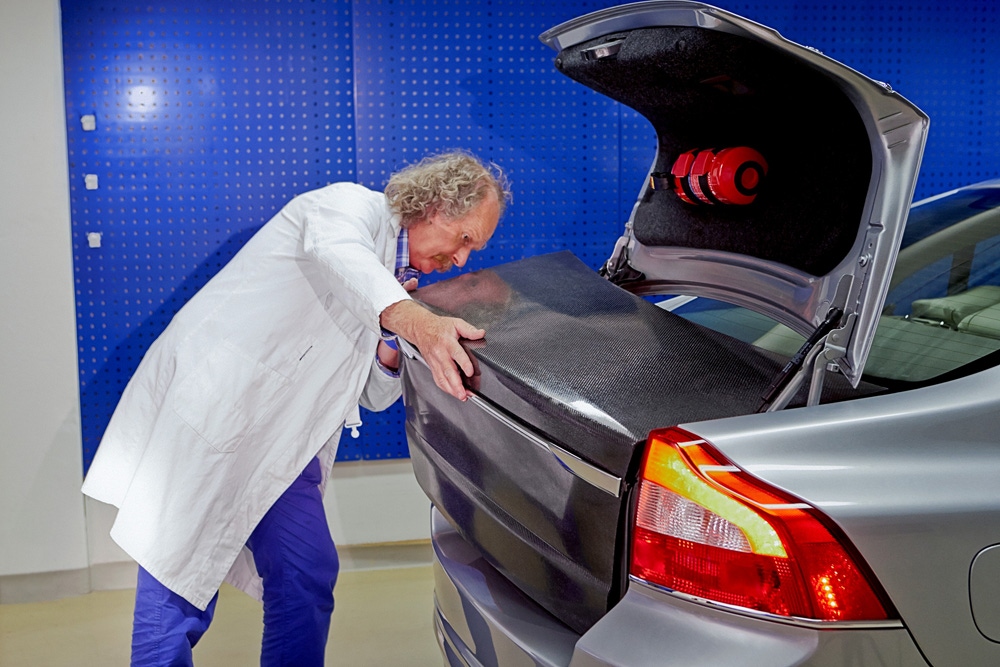Volvo Developing Battery Body Panels
Automaker says new energy-storage panels are lighter and more cost effective than traditional battery packs.

Volvo is working on a technology that would eliminate the traditional battery pack in electrified vehicles and replace it with body panels designed to store energy.
The special panels consist of reinforced carbon-fiber laminate and nano-structured lithium-ion batteries or super capacitors that are sandwiched together. Volvo says the material offers lighter energy storage, requires less space in the car and is eco-friendly and cost-effective.
Per-Ivar Sellergren, Volvo development engineer, has been heading up work on the energy-storage panels, which recently were installed on an S80 sedan test vehicle.
When the technology is based on supercapacitors, it has the capability to power a hybrid-electric vehicle, and when utilizing lithium-ion batteries it could be installed on an all-electric car, he says.
“A super capacitor gives you high power but not so much energy,” Sellergren tells WardsAuto. “It’s the opposite of the battery, which gives you a lot of energy but less power.”
The prototype S80 is a soft hybrid, he says, noting it only powers a stop-start system via a battery formed into a plenum cover, which typically is the plastic piece occupying the space under the hood between the windshield and engine. The test vehicle also has a battery trunk lid.
The plenum-shaped battery is so strong it is able to replace the rally bar, a strong structural piece that stabilizes the car in the front, and the stop-start battery. It also cuts 50% of the weight of a traditional setup, Volvo says.
In future demonstrations, Sellergren says the technology could be used to replace other parts of the car, including door panels, trunk lid and wheel bowls, all without sacrificing safety.
In the case of a collision, the panels, which are about 0.7 ins. (2 mm) thick, are designed to direct energy away from vehicle occupants and not release electricity.
“This battery has no hot liquid or leaking substances and has very large cooling areas, so there is no concentrated heat,” he says, noting the panels have yet to be crash-tested.
“We also have tried to minimize the risk for shocks by the decentralization of the energy and power storage,” Sellergren adds. “It’s around all the car, so there’s no concentration of this normally very high voltage. We spread it out in lower-voltage islands.”
While the sandwiched battery panels can be formed in most shapes, there are limits. Sellergren says he and his team so far have been able to bend the panels up to 90 degrees.
“We hope in the future we could begin with a plate and shape it as you want it,” he says. “You heat it a bit and you bend it and cool it and then have the shape you want.”
Volvo says it believes complete substitution of an electric car’s existing components with the new material could cut overall weight more than 15%.
Cost savings also would be significant because an automaker would be able to integrate many different components into one, Sellergren says.
“If you build a car which has a body that is a battery, you don’t need the standard body, because you already have that built into the battery cost,” he says. “So that’s one way to save money.”
Sellergren says currently there are no plans to put the material into production, noting the technology has to be further developed. If it were to enter production, he says Volvo would ensure it meets all of the automaker’s strict safety requirements.
“It could work and maybe not,” he says. “It’s very hard to convince the Volvo people, the customer and the whole chain because it’s very new thinking.”
About the Author
You May Also Like





